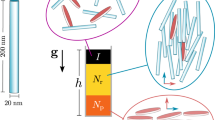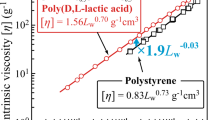Abstract
WHEN systems undergoing a rapid chemical re-equilibration between monomers and a single higher polymer are examined in the ultracentrifuge, a bimodal reaction boundary is predicted, if the degree of polymerization is greater than two1,2. The sedimentation coefficient of the monomer at infinite dilution, (SM)O may be found by extrapolation of the weight-average values, s̄, determined from the rate of movement of the position corresponding to the square root of the second moment of the entire schlieren diagram at a series of total protein concentrations3, or by examining the system in an environment where aggregation is inhibited. For example, the latter procedure was used to estimate (SM)O for α-chymotrypsin as ∼ 2.5 S4,5. The determination of the sedimentation coefficient of the polymer, sp, however, at a particular concentration (and hence (sp)O at infinite dilution) is difficult, for there is no defined position on the experimental schlieren pattern which corresponds to the position of the polymer at a given time. Certainly, an extrapolation of sfast, found from the rate of movement of the faster peak of the bimodal boundary, leads to serious error6,7. A value may be estimated on the basis of elementary theory8 and the equations of Perrin9, by assuming a model and assigning values to (SM)O and n2,7. The latter procedure is not satisfactory, in view of the importance of sp as an essential parameter in determining: (1) the value of the equilibrium constant from s data, which could be compared with that obtained from the Gilbert theory1; (2) the theoretical concentration dependence of s values for observed peaks in sedimentation velocity experiments1,7.
This is a preview of subscription content, access via your institution
Access options
Subscribe to this journal
Receive 51 print issues and online access
$199.00 per year
only $3.90 per issue
Buy this article
- Purchase on Springer Link
- Instant access to full article PDF
Prices may be subject to local taxes which are calculated during checkout
Similar content being viewed by others
References
Gilbert, G. A., Disc. Farad. Soc., 20, 68 (1955).
Gilbert, G. A., Proc. Roy. Soc., A, 250, 377 (1959).
Goldberg, R. J., J. Phys. Chem., 57, 194 (1953).
Massey, V., Harrington, W. F., and Hartley, B. J., Disc. Farad. Soc., 20, 24 (1955).
Neurath, H., and Dreyer, W. J., Disc. Farad. Soc., 20, 32 (1955).
Gilbert, G. A., Nature, 186, 882 (1960).
Gilbert, L. M., and Gilbert, G. A., Nature, 194, 1173 (1962).
Svedberg, T., and Pedersen, K. O., The Ultracentrifuge (Clarendon Press, Oxford, 1940).
Perrin, F., J. Phys. Radium, 7, 1 (1936).
Rao, N. S. N., and Kegeles, G., J. Amer. Chem. Soc., 80, 5724 (1958).
Townend, R., Winterbottom, R. J., and Timasheff, S. N., J. Amer. Chem. Soc., 82, 3161 (1960).
Gilbert, G. A., Disc. Farad. Soc., 25, 224 (1958).
Townend, R., and Timasheff, S. N., J. Amer. Chem. Soc., 82, 3168 (1960).
Timasheff, S. N., and Townend, R., J. Amer. Chem. Soc., 83, 464 (1961).
Author information
Authors and Affiliations
Rights and permissions
About this article
Cite this article
NICHOL, L., BETHUNE, J. Determination of Sedimentation Coefficients in Rapidly Equilibrating Polymerizing Systems. Nature 198, 880–881 (1963). https://doi.org/10.1038/198880c0
Issue Date:
DOI: https://doi.org/10.1038/198880c0
Comments
By submitting a comment you agree to abide by our Terms and Community Guidelines. If you find something abusive or that does not comply with our terms or guidelines please flag it as inappropriate.



